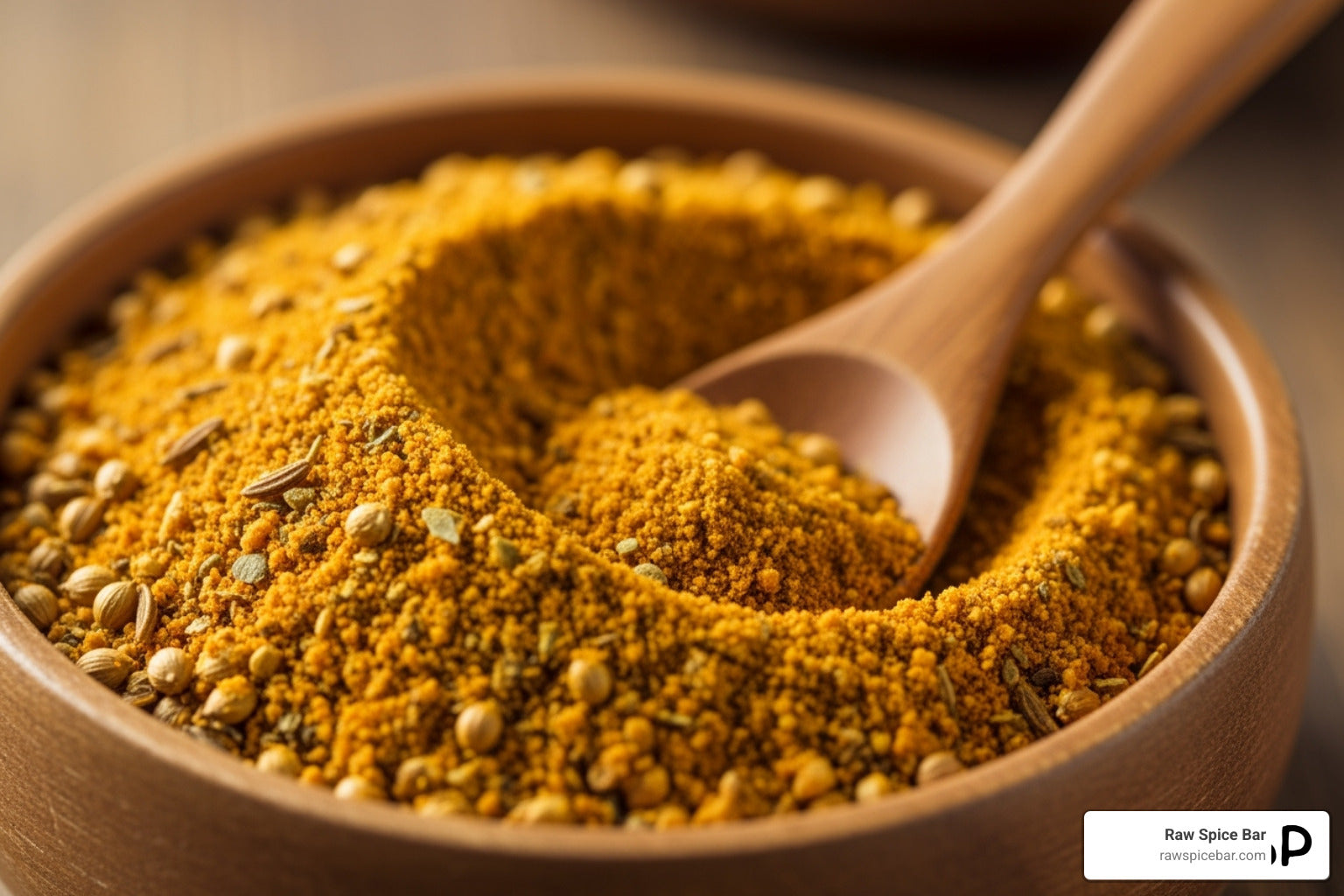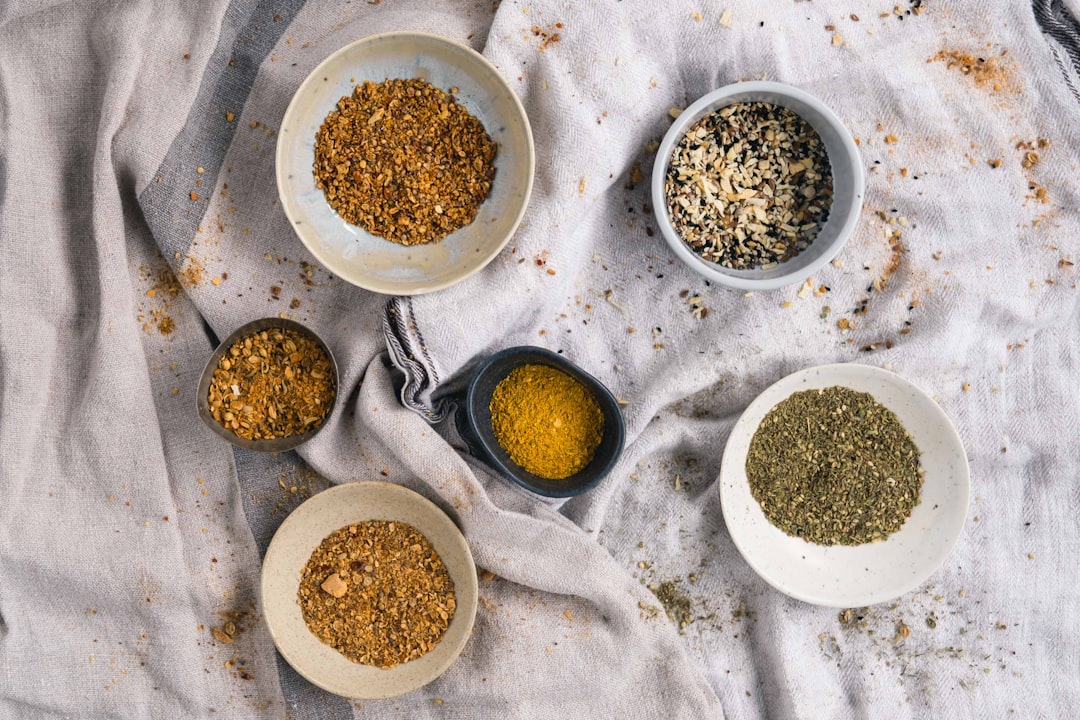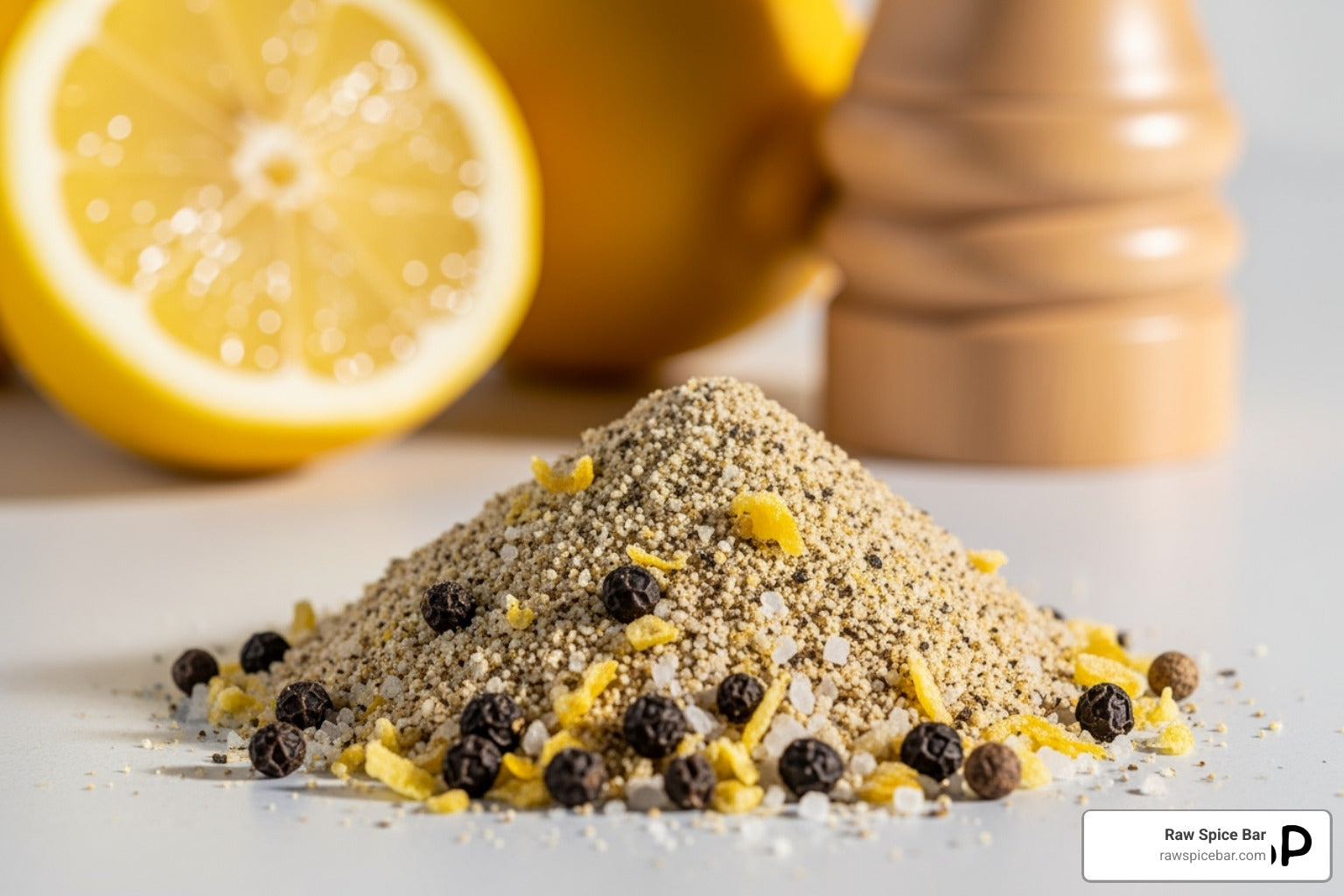Transforming everyday meals into extraordinary culinary experiences is easier than you think.
Enhance meats, vegetables, and sauces effortlessly by embracing fresh and authentic spice blends.
The key lies in elevating your dishes with flavors that are as vibrant and varied as the ingredients themselves. With the right spices, what once seemed plain can become complex, enticing, and deeply satisfying.
At Raw SpiceBar, our passion is crafting spice blends that capture the essence of cuisines worldwide. Each blend we create is designed to bring out the unique flavors in your dishes, encouraging you to explore and experiment. Our global spice subscription delivers these taste experiences right to your door, ensuring you always have the tools to transform ordinary meals into something special.
Say goodbye to bland and hello to bold. With our spice subscription, you can enjoy a seasonal selection of healthy, salt-free blends that inspire fun and easy cooking. Bring new life to your kitchen, and explore the delicious possibilities that await.
In this blog, we will cover:
-
How to balance taste elements and identify complementary flavor pairs.
-
The importance of selecting quality ingredients for meats, vegetables, and sauces.
-
Expert tips on cooking techniques that boost flavor effortlessly.
Say goodbye to bland and hello to bold!
By the end of this blog, you'll have all the tips and tricks you need to enhance every meal you make—effortlessly.
Understanding Flavor Profiles
Enhancing the flavor of meals begins with understanding how different elements come together. Balancing taste and identifying complementary flavor pairs can elevate meats, vegetables, and sauces to new heights.
Balancing Taste Elements
Balancing taste is crucial for crafting a delicious dish.
Focus on five key elements: salty, sweet, sour, bitter, and umami.
Each element plays a unique role. Salty elements enhance flavors; sweet balances tartness or bitterness. Sour adds brightness, while bitter can lend depth. Umami provides a savory richness found in ingredients like mushrooms and soy sauce.
Consider each element's role and how it can complement or counterbalance the other. Adjusting these components thoughtfully ensures that no single flavor dominates. This harmony helps create dishes that excite and satisfy the palate, turning ordinary meals into flavorful experiences.
Identifying Flavor Pairs
Identifying flavor pairs plays a key role in creating dishes with depth.
Certain combinations, like rosemary and garlic or lemon and thyme, are naturally complementary. These pairs enhance each other's qualities, resulting in a balanced dish.
When experimenting with spices, try different combinations to discover what works best for your palate. Use our blends to experiment with new flavors and bring global cuisines into your kitchen.
Selecting Quality Ingredients
Quality ingredients are key to enhancing your dishes. You can elevate your meals by choosing the best meats, fresh vegetables, and premium sauces. Let's explore how to select these ingredients to achieve flavorful results.
Criteria for Meats
When selecting meat, look for options that are fresh and high-quality.
-
Marbling, the fat within the meat, is crucial for tenderness and flavor.
-
The USDA grading system provides a guide for beef, with "Prime" being the highest quality, followed by "Choice."
-
Always check the smell and color of the meat. Fresh meat should have a mild scent and a vibrant color.
-
Avoid meats that look discolored or have an off smell.
-
Buying from trusted local butchers can also ensure freshness and help you support local businesses.
Choosing Fresh Vegetables
Fresh vegetables are essential for taking your dishes to the next level.
-
Look for produce that is bright in color and free from blemishes.
-
Leafy greens should be crisp and not wilted, while root vegetables like potatoes or carrots should be firm.
-
Try to purchase vegetables in season, which are often more flavorful and cost-effective.
Visiting a farmer's market can provide access to fresh, locally grown produce that typifies the season's flavors. This also supports sustainable farming practices.
Sourcing Premium Sauces
Sauces can add complexity and a burst of flavor to your meals.
When choosing them, focus on those made from natural ingredients without artificial preservatives. Many artisanal sauces offer unique blends that can be both sweet and savory.
You might explore stores or producers that specialize in small-batch, handcrafted sauces for the highest quality. We create spice blends that elevate your cooking experience. You can enjoy our global spice subscription for fresh, healthy, salt-free, authentic blends that perfectly complement your sauces.
Incorporating vibrant spices and high-quality ingredients can truly make your cooking stand out.
Preparation Techniques
Enhancing meats, vegetables, and sauces requires key techniques to bring out the best flavors. Mastering marination, cutting, and emulsification will add depth and flair to your dishes.
Meat Marination Basics
Marination is crucial for infusing meats with flavor and tenderness.
Start with choosing the right marinade: a mixture of acidic components like vinegar or lemon juice, oils, and spices from Raw Spice Bar’s blends.
Steps for marination:
-
Combine Ingredients: Mix your marinade using fresh herbs and spices.
-
Coat Evenly: Submerge the meat in the marinade fully.
-
Time it Right: Longer marination, generally up to 24 hours, deepens flavor.
Proper marination transforms simple meats into delightful dishes. Experiment with spice blends to discover new tastes.
Vegetable Cutting Skills
Proper vegetable cutting ensures even cooking and enhances presentation. Key skills include julienning, dicing, and chiffonade.
-
Julienning creates matchstick cuts perfect for stir-fries.
-
Dicing provides uniform pieces for soups or stews.
-
Chiffonade is used for leafy greens, creating thin strips for garnishes.
Remember to:
-
Use sharp knives for precision.
-
Practice uniformity to ensure even cooking.
-
Keep fingers safe by learning proper hand positioning.
Using cutting skills, vegetables become a visual and flavorful highlight.
Sauce Emulsification
Emulsification is the process of blending two liquids that normally don't mix, like oil and vinegar. It's crucial for creamy and cohesive sauces.
To emulsify:
-
Begin Slowly: Add the oil gradually into the vinegar or another liquid while whisking.
-
Maintain Speed: Consistent whisking helps blend the ingredients.
-
Balance Flavors: Use balanced quantities for a stable emulsion.
For enhanced taste, consider using our spice blends. This can improve your sauce's flavor and add a creative twist to traditional recipes. Emulsified sauces add creaminess and depth, making dishes stand out.
Cooking Methods
Enhancing your dishes involves choosing the right techniques for cooking meats, vegetables, and sauces. Each method beautifully draws out flavors and textures, ensuring each ingredient reaches its full potential.
Grilling and Searing Methods
Grilling and searing add intense flavor to your meats.
When you grill, you use high heat to cook meat quickly, locking in juices and creating a tasty char on the surface.
Searing is similar but usually done in a pan. The technique involves cooking meat at high temperatures until the outer layer browns. This process forms a flavorful crust, enhancing the meat's natural taste.
Spice blends deepen flavor profiles and explore global tastes for extra zest.
Steaming and Boiling Vegetables
Steaming and boiling are great for highlighting the natural flavors of vegetables.
-
Steaming retains nutrients while cooking vegetables evenly. A steamer basket is placed over boiling water, keeping the veggies from direct contact with water. This method preserves color, flavor, and texture.
-
Boiling quickly cooks vegetables in salted water. To keep veggies from turning mushy, cook them until they're tender. Adding citrus zest or aromatic oils can enhance taste and aroma, giving your veggies an intriguing twist.
Consider trying our spice blends to elevate these simple methods with flavors worldwide.
Simmering and Reducing Sauces
Simmering is key to crafting sauces that are rich and full of flavor.
-
Mix ingredients like tomatoes, herbs, and spices in a saucepan.
-
Cook at a low heat to allow flavors to meld and depth to develop. Reducing involves letting the liquid evaporate to intensify the taste and thicken the sauce.
-
Aromatic additions, like mixed citrus zests, can add complexity and brightness.
-
Fresh blends from a spice subscription can transform a simple sauce into something noteworthy.
Combined with the right spice blends, these methods help create memorable dishes that excite the palate.
Seasoning and Spicing
Enhancing the taste of your dishes involves carefully selecting and blending the right herbs and spices. Whether using ready-made blends or creating your own, understanding how to incorporate these flavors is key.
Herbs and Spices Selection
Choosing the right herbs and spices can transform a simple dish into a culinary delight.
Freshness is crucial; stale spices won't deliver the intensity you need. For instance, Herbes de Provence, with its rich blend of flavors, effortlessly elevates meats and vegetables.
Consider the dish you are preparing. Rosemary pairs well with lamb, while basil suits tomato-based sauces. Keep a variety of spices on hand to suit different cuisines. Ensure your selection is properly stored in airtight containers to maintain its potency.
Creating Seasoning Blends
Crafting your seasoning blends allows you to tailor flavors to your preference.
You can experiment with combinations of herbs and spices at home, creating unique mixes to enhance your meals. Start with classic combinations, such as Puerto Rican Sazon for rice and meats.
Our team specializes in crafting spice blends from fresh, vibrant ingredients sourced worldwide. With our global spice subscription service, you can receive new blends with recipe cards every month. This service is perfect for easy, flavorful cooking that's both seasonal and healthy.
Embrace the fun of customizing blends that suit your taste and transform ordinary dishes into something extraordinary.
Final Touches and Presentation
Bringing out the best flavors and looks in your dishes is crucial. By focusing on plating and garnishing, your meals can become a feast for the taste buds and the eyes.
Plating Techniques
Plating is about arranging food to look its best. Use different colors and shapes to interest diners visually.
A white plate makes ingredients stand out. Keeping spaces around the food can create focus and balance. Organization matters. Place food in layers for texture and height. Keeping simplicity in mind helps prevent overcrowding, so each component has its moment to shine.
Consider using various serving tools for creative layouts. For example, a ring mold can neatly stack dishes like rice or pasta. These methods can transform meals into attractive displays, enhancing the dining experience.
Garnishing for Visual Appeal
Garnishing adds beauty and flavor to your dishes.
Fresh herbs like parsley or cilantro offer nice pops of color and fresh taste. Citrus zest also enhances appearance and introduces fragrant notes. Choose garnishes that complement the main dish. Sometimes less is more, so don't overpower the dish with too much decoration.
Sticking to vibrant colors or edible flowers can brighten plates without stealing attention from the main course. With thoughtful garnishing, your meals become delicious and visually stunning.
Maintaining Kitchen Equipment
Taking care of your kitchen tools is crucial for their longevity and performance. Proper knife maintenance ensures they remain sharp and safe, while cookware requires specific upkeep to avoid damage and ensure even cooking.
Knife Care and Sharpening
Knives are essential in the kitchen; keeping them sharp is important for efficiency and safety.
Regularly hone your knives with a honing rod to maintain the edge. For deeper sharpening, use a whetstone. Start with the coarse side, then move to the fine side for a polished edge.
Store your knives properly to protect them. A knife block or magnetic strip can prevent unnecessary wear. Always hand wash and dry knives immediately after use to prevent rust or damage.
Tip: Avoid cutting on hard surfaces like glass; instead, use a wooden or plastic cutting board.
Cookware Upkeep
Proper care of your cookware extends its lifespan and ensures even cooking.
Soak stainless steel in soapy water to remove any stuck-on food, then scrub with a non-abrasive pad. Avoid high heat settings to prevent warping.
Non-stick pans require gentle care. Use wooden or silicone utensils to avoid scratching the surface. Hand wash with mild detergent and a soft sponge, and avoid stacking them to prevent damage.
Cast Iron Care: Season regularly with oil to maintain the non-stick surface and prevent rusting.
Storing Leftovers
Properly storing leftovers can help keep meals tasty and safe to eat later. The right refrigeration and freezing techniques can help maintain the flavor and quality of your dishes.
Proper Refrigeration Practices
Refrigeration is key in preserving the taste and safety of your leftovers.
-
First, let hot food cool a bit so your fridge doesn't work too hard.
-
Meal portions should be stored in shallow, airtight containers. This helps them cool evenly and reduces the growth of bacteria.
-
Aim to place them in your fridge within two hours. Keeping the fridge's internal temperature at 40°F (4°C) or lower keeps leftovers in good condition.
-
When you organize your fridge, put older leftovers in front so you eat them first and they don't go to waste.
Freezing Techniques
Freezing is great for extending the life of your meals.
Our delicious spice subscription blends can keep your leftovers flavorful, even after freezing.
Use freezer-safe bags or containers. Squeeze out as much air as possible before sealing. Labeling each package with the date and contents helps you track how long they’ve been stored.
Freeze foods in individual portions for convenience. This makes defrosting quicker and ensures each portion tastes fresh. For best quality, use most frozen leftovers within three months.
Reheat frozen items thoroughly, and you'll have meals almost as delicious as when they were first cooked.
Frequently Asked Questions
Curious about how to enhance your cooking skills and take your dishes to the next level? You're not alone! Many home chefs are always looking for ways to improve the flavors and textures of meats, vegetables, and sauces. Here, we’ll answer some of the most common questions on how to boost your meals with expert techniques, spices, and ingredient swaps. Ready to get started?
How can you achieve the Maillard reaction when cooking meats and vegetables?
To achieve the Maillard reaction, cook at a high temperature and ensure the surface of your meats or vegetables is dry. This reaction gives a delicious crust and deep flavor. Use your favorite spice blends from Raw Spice Bar to add more flavor.
What are healthy ways to make vegetables taste better?
Roasting with spices does wonders for vegetable flavor. The heat caramelizes natural sugars, making them sweeter. Adding a pinch of lemon juice or zest can make them pop. Use salt-free spice blends to keep it healthy.
What ingredients can elevate the flavors in a meatless soup?
Boost flavors in meatless soups with umami-rich ingredients like mushrooms, seaweed, or nutritional yeast. A splash of soy sauce can also enhance depth. Try adding fresh herbs or a dash of spice for a unique twist.
What culinary techniques can improve the savoriness of sauces?
To improve the savoriness, try sautéing garlic and onions early in the cooking process. Allow sauces to reduce for a concentrated flavor. Consider adding a small amount of vinegar or wine to enhance depth.
What are some effective vegetarian substitutes that mimic meat flavors in recipes?
Ingredients like mushrooms, lentils, and jackfruit can mimic the texture and flavor of meat. The right spice blends, such as those from Raw Spice Bar, can further enhance the flavors, making these substitutes taste more like meat.
How can one intensify the beef flavor in dishes without using actual beef?
Using ingredients like miso paste, soy sauce, or Worcestershire sauce to intensify beef flavors without meat. These add a deep umami flavor that beef dishes are known for. Also, using robust, beef-friendly spices can enhance the overall taste.




